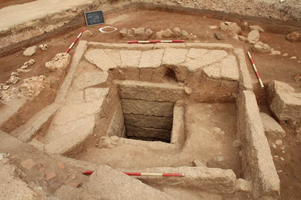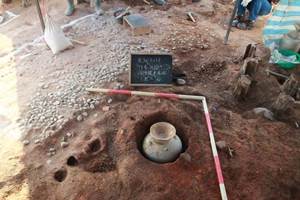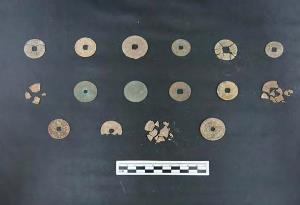Well reveals history of Hong Kong
|
Following the discovery of the remnants of Lung Tsun Stone Bridge and the former Kowloon City Pier at the north apron of the former Kai Tak Airport in 2008, archaeologists have unearthed remnants and relics that date back to the Song and Yuan Dynasties in the Sacred Hill (North) Study Area of the Mass Transit Railway Corporation (MTRC)’s Sha Tin to Central Link (SCL) (Tai Wai to Hung Hom Section) in the Kai Tak Development Area. Among the relics unearthed is a well-preserved square-shaped well of the Song and Yuan Dynasties, the first of its kind ever found in Hong Kong, indicating that there were people living in the Kai Tak area more than a thousand years ago. You may know that the Sung Wong Toi Inscription Rock and the Sacred Hill were cut down and removed for the expansion of the Kai Tak Airport during the Second World War. Legend has it that the Song Emperor once fled to the Sacred Hill and its vicinity from China. Professor James Watt, a scholar, discovered Song-style pottery in the area as early as the 1970s. The SCL railway development project now provides an opportunity for us to conduct a systematic review of the historical and cultural heritage of the area under the mechanism of the Environmental Impact Assessment Ordinance. As shown in the approved environmental impact assessment report of the SCL project (Tai Wai to Hung Hom Section), the works would probably affect the relics buried underground to the north of the Sacred Hill. In view of this, the MTRC commissioned archaeologists to conduct archaeological survey-cum- excavation in accordance with the environmental permit in November 2012. Completed at the end of last year, the work lasted more than a year with an excavation area of about 14 500 square metres, which was divided into 164 pits based on the conditions on site. Inside one of the test pits located in the additional survey area, the archaeologists discovered the well mentioned above and advised the Government to preserve it in-situ due to its good condition. At the end of last year, the Government informed the Antiquities Advisory Board of the discovery. Since the well is located at the site of a proposed carriageway of Road L9 of the Stage 5 Infrastructure Works, the Civil Engineering and Development Department has changed the alignment of the proposed carriageway so as to conserve the archaeological relics. The carriageway will be diverted from the location of the well to facilitate its preservation and future display. Furthermore, to better protect the well from deterioration and natural corrosion, the Government has set up a protection area whereby the well is covered with protective materials and then backfilled with sand to preserve it in a stable buried environment. This method is commonly used in the Mainland, Europe and the United States to provide better conditions for the future re-excavation of relics. From the discovery of the well to the discussion of its in-situ preservation proposal, the Government departments concerned have made concerted efforts to find a win-win solution to the dual challenges of urban development and heritage conservation. Currently, no other relics of comparable archaeological value worthy of in-situ preservation have been found in the vicinity. The departments concerned will, before commencing road construction works near the square-shaped well, engage archaeologists to conduct further archaeological surveys to ensure compliance of the works with heritage conservation requirements. In addition to the well, the archaeologists have also discovered three underground strata during the survey and excavation works, namely a layer of fill soil formed between the 1920s and 1960s at the top, a layer dating from the late Qing Dynasty to the period of the Republic of China in the middle and a layer dating to the Song-Yuan Dynasties at the bottom. The relics in the “fill soil layer” are mainly the foundations of buildings and structures related to housing development, reclamation works or the construction of the former Kai Tak Airport. For the “late Qing-Republic of China layer”, the relics are associated with agricultural activities at the time, such as irrigation ditches, septic tanks, ash pits and wells. In the “Song-Yuan layer”, there are mostly the remains of houses, wells, kilns, tombs, ash pits and trash pits, bearing traces of people living in Kowloon City during the Song Dynasty. Commissioned by the MTRC to lead the archaeological work, the archaeologists have made detailed records of the relics and collected the unearthed relics for further study. According to preliminary statistical analysis, around 3 700 pieces of important artefacts and more than 1 000 boxes of common artefacts have been kept, including items such as ceramic shards, coins, metal fragments and wood. The coins date from the modern age to the Tang Dynasty, with examples from the Kai Yuan Tong Bao in 621 AD, Yuan Feng Tong Bao, Shao Sheng Yuan Bao and Qian Long Tong Bao in the late Qing Dynasty, as well as a one-cent coin from modern Hong Kong dated 1926. Owing to the enormous amount of unearthed archaeological relics, the archaeologists are still conducting research on the findings, and a thorough assessment will be released in the final report. The interpretation arrangements for the well have yet to be explored by the relevant departments. One proposal worth considering is to undertake comprehensive planning for the well together with the proposed Sung Wong Toi Park, so that the community can appreciate the remnants of the Lung Tsun Stone Bridge, which was built in the 18th century and has witnessed the history of the Kowloon City District, while also having a look at the newly unearthed remnants and relics that date from the Song and Yuan Dynasties to the 1960s. In fact, under the heritage impact assessment mechanism, all proponents of new capital works projects as well as relevant works departments are required to examine whether the projects will affect sites or buildings of historic or archaeological significance. If they will, heritage impact assessments, mitigation measures and public engagement activities have to be carried out. The Kai Tak Development mentioned above is a good example to illustrate that even though a number of inter-related, large-scale and complicated works projects are involved, the Government will still strive to conserve heritage while completing the projects in phases according to the schedule. |
|
20 April, 2014
Back

